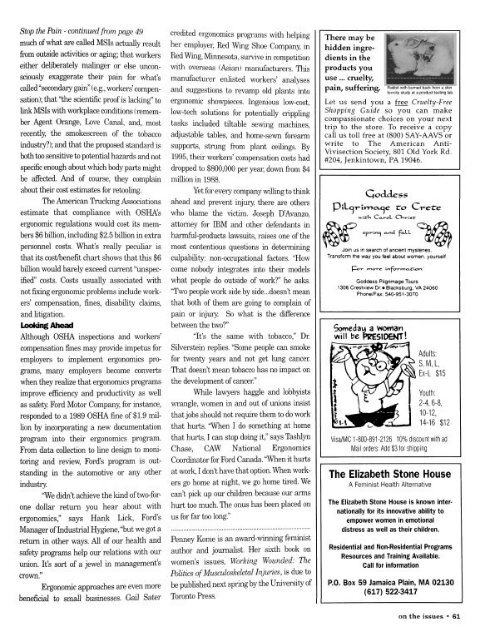women histories, incest sexual abuse. institutionalized. But what if ...
women histories, incest sexual abuse. institutionalized. But what if ...
women histories, incest sexual abuse. institutionalized. But what if ...
You also want an ePaper? Increase the reach of your titles
YUMPU automatically turns print PDFs into web optimized ePapers that Google loves.
Stop the Pain - continued from page 49<br />
much of <strong>what</strong> are called MSIs actually result<br />
from outside activities or aging; that workers<br />
either deliberately malinger or else unconsciously<br />
exaggerate their pain for <strong>what</strong>'s<br />
called "secondary gain" (e.g., workers' compensation);<br />
that "the scient<strong>if</strong>ic proof is lacking" to<br />
link MSIs with workplace conditions (remember<br />
Agent Orange, Love Canal, and, most<br />
recently, the smokescreen of the tobacco<br />
industry?); and that the proposed standard is<br />
both too sensitive to potential hazards and not<br />
spec<strong>if</strong>ic enough about which body parts might<br />
be affected. And of course, they complain<br />
about their cost estimates for retooling.<br />
The American Trucking Associations<br />
estimate that compliance with OSHA's<br />
ergonomic regulations would cost its members<br />
$6 billion, including $2.5 billion in extra<br />
personnel costs. What's really peculiar is<br />
that its cost/benefit chart shows that this $6<br />
billion would barely exceed current "unspec<strong>if</strong>ied"<br />
costs. Costs usually associated with<br />
not fixing ergonomic problems include workers'<br />
compensation, fines, disability claims,<br />
and litigation.<br />
Looking Ahead<br />
Although OSHA inspections and workers'<br />
compensation fines may provide impetus for<br />
employers to implement ergonomics programs,<br />
many employers become converts<br />
when they realize that ergonomics programs<br />
improve efficiency and productivity as well<br />
as safety. Ford Motor Company, for instance,<br />
responded to a 1989 OSHA fine of $1.9 million<br />
by incorporating a new documentation<br />
program into their ergonomics program.<br />
From data collection to line design to monitoring<br />
and review, Ford's program is outstanding<br />
in the automotive or any other<br />
industry.<br />
"We didn't achieve the kind of two-forone<br />
dollar return you hear about with<br />
ergonomics," says Hank Lick, Ford's<br />
Manager of Industrial Hygiene, "but we got a<br />
return in other ways. All of our health and<br />
safety programs help our relations with our<br />
union. It's sort of a jewel in management's<br />
crown."<br />
Ergonomic approaches are even more<br />
beneficial to small businesses. Gail Sater<br />
credited ergonomics programs with helping<br />
her employer, Red Wing Shoe Company, in<br />
Red Wing, Minnesota, survive in competition<br />
with overseas (Asian) manufacturers. This<br />
manufacturer enlisted workers' analyses<br />
and suggestions to revamp old plants into<br />
ergonomic showpieces. Ingenious low-cost,<br />
low-tech solutions for potentially crippling<br />
tasks included tiltable sewing machines,<br />
adjustable tables, and home-sewn forearm<br />
supports, strung from plant ceilings. By<br />
1995, their workers' compensation costs had<br />
dropped to $800,000 per year, down from $4<br />
million in 1988.<br />
Yet for every company willing to think<br />
ahead and prevent injury, there are others<br />
who blame the victim. Joseph D'Avanzo,<br />
attorney for IBM and other defendants in<br />
harmful-products lawsuits, raises one of the<br />
most contentious questions in determining<br />
culpability: non-occupational factors. "How<br />
come nobody integrates into their models<br />
<strong>what</strong> people do outside of work?" he asks.<br />
'Two people work side by side...doesn't mean<br />
that both of them are going to complain of<br />
pain or injury. So <strong>what</strong> is the d<strong>if</strong>ference<br />
between the two?"<br />
"It's the same with tobacco," Dr.<br />
Silverstein replies. "Some people can smoke<br />
for twenty years and not get lung cancer.<br />
That doesn't mean tobacco has no impact on<br />
the development of cancer."<br />
While lawyers haggle and lobbyists<br />
wrangle, <strong>women</strong> in and out of unions insist<br />
that jobs should not require them to do work<br />
that hurts. "When I do something at home<br />
that hurts, I can stop doing it," says Tashlyn<br />
Chase, CAW National Ergonomics<br />
Coordinator for Ford Canada. "When it hurts<br />
at work, I don't have that option. When workers<br />
go home at night, we go home tired. We<br />
can't pick up our children because our arms<br />
hurt too much. The onus has been placed on<br />
us for far too long."<br />
Penney Kome is an award-winning feminist<br />
author and journalist. Her sixth book on<br />
<strong>women</strong>'s issues, Working Wounded: The<br />
Politics ofMusculoskeletal Injuries, is due to<br />
be published next spring by the University of<br />
Toronto Press.<br />
There may be<br />
hidden ingredients<br />
in the<br />
products you<br />
use... cruelty,<br />
pain, suffering.<br />
Rabbit with bui<br />
loxicity study at a product testing lab.<br />
Let us send you a free Cruelty-Free<br />
Shopping Guide so you can make<br />
compassionate choices on your next<br />
trip to the store. To receive a copy<br />
call us toll free at (800) SAY-AAVS or<br />
write to The American Anti-<br />
Vivisection Society, 801 Old York Rd.<br />
#204, Jenkintown, PA 19046.<br />
|3iL

















